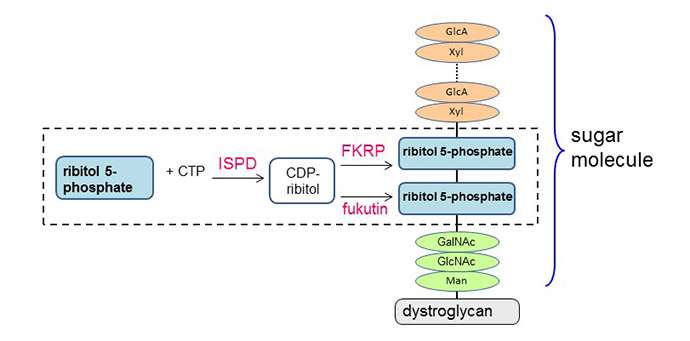Decoding sugar molecules offers new key for combating muscular dystrophy

A group of Japanese scientists have succeeded in decoding a sugar molecule and clarifying a mechanism linked to muscular dystrophy. Their discovery has potential implications for muscular dystrophy treatment. The results of their research were published in the journal Cell Reports on February 25, 2016 EST.
Key research group members include Professor TODA Tatsushi, Associate Professor KANAGAWA Motoi, and Associate Professor KOBAYASHI Kazuhiro from the Kobe University Graduate School of Medicine; Doctor ENDO Tamao, Vice-director from the Tokyo Metropolitan Institute of Gerontology; and Doctor WADA Yoshinao, Director of the Osaka Medical Center and Research Institute for Maternal and Child Health.
Muscular dystrophy is an incurable genetic condition marked by progressive weakening of the muscles. The condition is caused by mutations in the genes responsible for muscle structure and functions. Previous research had revealed three major genes involved in a certain family of muscular dystrophies: fukutin, fukutin-related proteins (FKRP), and isoprenoid synthase domain-containing (ISPD). When these three genes do not function correctly, abnormalities occur in the sugar molecules that bind to the dystroglycan protein on the surface of muscle cells. However, until now the exact composition of the sugar molecules and the role of these genes was unclear.
Professor Toda's research group succeeded in creating a sugar molecule in a cell culture. Using mass spectrometric analysis, they calculated the mass of each component in the sugar molecule and identified an unusual sugar unit called "ribitol 5-phosphate". The group went on to discover that three causative genes of muscular dystrophy (ISPD, fukutin, and FKRP) are all involved in creating this sugar unit. In a patient cell model with each of these three genes removed, ribitol 5-phosphate was also absent, proving that the abnormal synthesis of ribitol 5-phosphate is a cause of the condition. When CDP-ribitol, one of the ingredients for ribitol 5-phosphate, was added to the cell model, the abnormalities in the sugar molecule were resolved.
The sugar unit ribitol 5-phosphate was previously only confirmed in bacteria and some plants, so the researchers were surprised to discover that in mammals it functions as a component of sugar-protein interactions. They suggest that the sugar unit also has a key role in embryonic tissue development. Abnormalities in its combination with proteins could cause cancer metastasis and viral infection as well as muscular dystrophy.
"Sugar molecules play a key role in many biological processes, but their composition is difficult to determine and research on them is still limited", said Professor Toda. "The decoding of this sugar molecule has implications for the field of life sciences, as well as being a step further in the treatment of muscular dystrophy."
More information: Motoi Kanagawa et al. Identification of a Post-translational Modification with Ribitol-Phosphate and Its Defect in Muscular Dystrophy, Cell Reports (2016). DOI: 10.1016/j.celrep.2016.02.017















